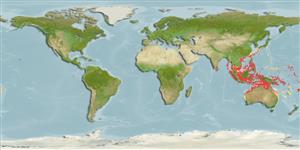Teleostei (teleosts) >
Kurtiformes (Nurseryfishes, cardinalfishes.) >
Apogonidae (Cardinalfishes) > Apogoninae
Etymology: umbratilis: Name from a Latin word meaning 'of the shade', retired or private, referring to the
observed cryptic behavior..
Environment: milieu / climate zone / depth range / distribution range
Ecology
Marine; pelagic-neritic; depth range 20 - 60 m (Ref. 90102). Tropical
East Indian to Western Pacific: Western Australia, Indonesia, Brunei and Palau.
Size / Weight / Age
Maturity: Lm ? range ? - ? cm
Max length : 4.1 cm SL male/unsexed; (Ref. 83499)
Short description
Identification keys | Morphology | Morphometrics
Dorsal spines (total): 8; Dorsal soft rays (total): 9 - 10; Anal spines: 2; Anal soft rays: 8 - 9. This species is characterized by having a blackish spot on the first-dorsal fin; 5 brownish bars on body and caudal peduncle; broad faint cheek mark; high postocular darkish spot; 14 pectoral-fin rays with a tiny to small darkish spot above the axil (Ref. 83499).
This species is usually found solitary or in pairs at about 10-40 meters. It also displays a cryptic behavior, at least during daylight hours, sheltering between rocks and rubble. It has not been observed free swimming, but only when flushed from its lair with the use of clove-oil or rotenone. Specimens collected were living in a rubble field in sheltered waters at the base of a small islet or were found under rock slabs on a submerged patch reef (several km from shore) with abundant sponges and gorgonians and minimal hard corals. Some specimens were also collected from a flat sand and shell bottom with abundant Gonipora, some Fungia and considerable macroalgae (Ref. 83499).
Life cycle and mating behavior
Maturities | Reproduction | Spawnings | Egg(s) | Fecundities | Larvae
Mouthbrooders. Distinct pairing during courtship and spawning (Ref. 205).
Fraser, T.H. and G.R. Allen, 2010. Cardinalfish of the genus Apogonichthyoides Smith, 1949 (Apogonidae) with a description of a new species from the West-Pacific region. Zootaxa 2348:40-56. (Ref. 83499)
IUCN Red List Status (Ref. 130435)
Threat to humans
Harmless
Human uses
Fisheries: of no interest
Tools
Special reports
Download XML
Internet sources
Estimates based on models
Preferred temperature (Ref.
123201): 24.3 - 28.5, mean 27.6 °C (based on 221 cells).
Phylogenetic diversity index (Ref.
82804): PD
50 = 0.5000 [Uniqueness, from 0.5 = low to 2.0 = high].
Bayesian length-weight: a=0.01479 (0.00690 - 0.03171), b=3.09 (2.91 - 3.27), in cm total length, based on LWR estimates for this (Sub)family-body shape (Ref.
93245).
Trophic level (Ref.
69278): 3.3 ±0.5 se; based on size and trophs of closest relatives
Fishing Vulnerability (Ref.
59153): Low vulnerability (10 of 100).
